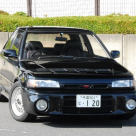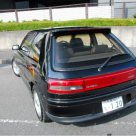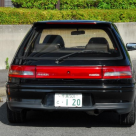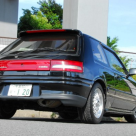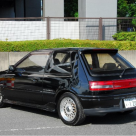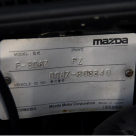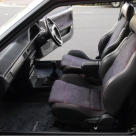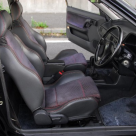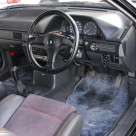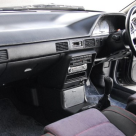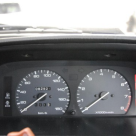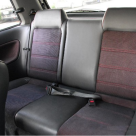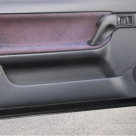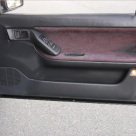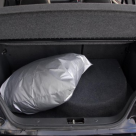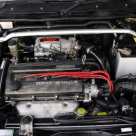1992 Mazda Familia Gen 6 (BG) GT-R
Specifications
Vehicle location
United Kingdom , Unknown , Unknown
You don't see many around, and with only 2,500 units produced for rally homologation purposes, we're lucky if there’s a handful in any market outside of Japan. Originally sold only in the Japanese domestic market, the Familia GT-R is from the golden age of ‘Group A’ rally, when manufacturers had to produce rally cars which were based on actual road cars built in minimum numbers; the requirement at the time being 2,500 units.

The ‘Group A’ rules in both rally and touring cars are a major reason behind such amazing road vehicles throughout the late 1980s and early 1990s, with many famous nameplates built to satisfy the requirements, including the Lancer Evo, Celica GT-Four, Lancia Delta Integrale and many more. Among these ‘Group A’ heroes, the Mazda GT-R is not very well known, and is an under-rated and under-recognised car in our opinion. It's certainly a viable competitor for many other early Group A cars, including a very similar ‘Group A’ rally entry - the Nissan Pulsar GTiR. Interestingly, early communications within the Mazda Corporation suggest the GT-R was designed to take the WRC crown from the famous Lancia Delta Integrale, which had dominated rallying throughout the late 1980s. If you look at the price of Delta Integrales compared to GT-Rs, you will see why the Mazda represents such a tempting opportunity. GT-R prices would no doubt be at a similar level if they had the same motorsport success levels as Lancia. Although the GT-R was not the dominating force Mazda had expected in the WRC, significant victories have been achieved by the cars in Group N racing and other privateer events around the world, making these cars a desirable choice, particularly for amateur rally entrants.
Despite their limited production run and impressive performance, the Familia GT-R is often available in the sub-10K price bracket these days (2016), so we thought it would be a good idea to start recording some of these cars on the register, and increase awareness of these cars to potential collectors. As a homologated rally car, we don’t think you could go too wrong with one of these in the garage as a long term investment.
This particular car has already sold as an aftermarket import in the UK, through New Era Imports, who have imported several Mazda GT-Rs to the UK in the past. These cars are often difficult to find in good condition, as so many have been stripped for rallying and racing purposes, and like many sports cars, have been driven fairly hard throughout their lives. We understand the car sold for around £6,000 a couple of years ago, representing a reasonable price for a car in good condition (auction grade 4), but on the high-side when compared to some of the prices currently seen in Australia and Japan. For example, two GT-Rs currently sit on Gumtree Australia here and here, asking just over $5,000 (AUD) each. No doubt a bit of work would be needed on these cheaper cars to bring them up to a reasonable condition, but you can’t argue over Group A cars at that sort of price.

The GT-R is equipped with a 1.8l DOHC single turbo engine, producing 210BHP (154kw) from the factory. The engine is connected to a 5-speed manual transmission, a viscous LSD and a limited-slip 4WD system providing drive bias of 47% at the front, and 53% at the rear under static conditions. A substantial amount of work was done to the engine to bring it up to a competitive rally standard, and there are significant differences between the mechanicals in the GT-R and those in the Familia GT-X. For example, there is a larger ball bearing turbo, tougher engine mounts, larger sodium filled valves, revised profile hollow cams, ported exhaust manifold and re-mapped computer. The GT-R also received a significantly larger intercooler, revised sway bar, upsised brakes, faster steering ratio, strengthened gearbox and clutch, among other performance features. These items can assist in determining a genuine GT-R from the GT-X model.
Despite the modifications, the GT-R was still a comfortable road car, packed with several ‘luxury’ features for a hatch of the early 1990s. Those features included power steering, electric windows, electric mirrors, optional electric glass sunroof, half leather - half perforated suede interior trim, air-conditioning, Nardi steering wheel and tinted windows. This level of equipment clearly added a lot of weight to the car, which explains why so many have been stripped for rallying purposes over the years. In this regard, a limited run of 300 vehicles known as the GT-Ae were also produced, which were 30kg lighter, but fitted with the same mechanicals.

These cars are getting on in the years now, but the good news is they’re about to become old enough to be placed on club registration (at least within Australia and some other countries). This means you can get discounted insurance, and quite easily use them as a weekend car to go to club events if you don’t want to use the car as a daily driver. This is a major benefit which is closing in on many of the early 1990s Group A sports cars in the coming years.
If you have a Familia GT-R, please put it on the register or contact us so we can add your car. We only have a few of these cars on the register which can be seen by clicking here. We would love to know where the other remaining cars have ended up, whether in Japan, or throughout the world. We look forward to seeing these cars attracting further interest from collectors in the future.
To keep in touch with the most interesting cars added to the register, and our latest ID-guides, follow us on Facebook.
You are about to contact the author of this vehicle.
Be aware this vehicle has currently not been listed for sale!
So refrain from price bidding.

